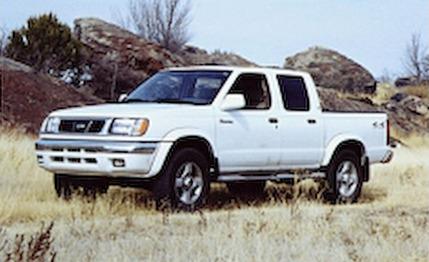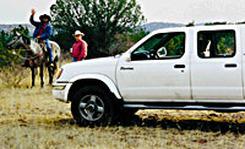
 Long-Term Road Test
Long-Term Road Test
When the 2000 Frontier crew cab was introduced in '99, it was the first compact pickup sold in the U.S. with four doors. We're talking four "real," forward-hinged doors -- each with its own outside handle. We picked up a Frontier in May from Nissan's plant in Smyrna, Tennessee, and its "half four-door car, half short-bed truck" look attracted lots of attention. Since then other four-doors have appeared, including the '00 Dodge Dakota Quad Cab and the '01 Ford Explorer Sport Trac.
When we road-tested this four-wheel-drive crew cab SE (C/D, August 1999), we liked its standard V-6, its smooth ride, and the maneuverability of its compact dimensions. But we wondered if the short cargo box and somewhat cramped rear seat of this "compromised vehicle" would limit its appeal and/or utility. To find out, we added a few dealer-installed options to the truck and set out to rack up 40,000 miles.
The crew cab's bed is more than 20 inches shorter than that of a standard Frontier, so the optional $229 tubular aluminum flip-style cargo cage seems almost a necessity. It extends bed length from 54.7 inches to about 72 inches when the tailgate is down, and it can be used to compartmentalize loads when the gate is closed. A plastic bed liner ($299) and a set of floor mats ($79) were also added. We paid a local dealer $65 to install the bed liner and extender.
Otherwise, our $24,512 truck was equipped with an automatic transmission ($1050) and a Power package with cruise control ($1080). The SE trim ($1300), a step up from XE, includes 16-inch wheels and tires, fog lamps, step rails, and a sliding rear window.
Early on, staffers praised the Frontier's civilized, carlike ride and the decent acceleration provided by its 3.3-liter SOHC V-6. The large knobs and buttons on the dash and the idiot-proof ergonomic layout were appreciated, as was the convenience of the two "real" rear doors. And the Frontier's relatively small turning circle and tidy dimensions were popular with the city folk.
Complaints were also logged, though, about skimpy seat padding and dirty pant legs caused by step rails too narrow to actually use but too wide to avoid when exiting. And the Frontier's "soft" suspension prompted art guy Winter to comment: "Love the way the truck rocks back and forth when you come to a stop abruptly."
Contributing editor Scoutten also noted an "uncontrolled" suspension and "too much body roll." But he liked the comfortable ride and the fact that he could use the rear seat as lockable, dry storage space.

Scoutten frequently dresses in Johnny Cash black, so it's no surprise he hated the step rails -- and their imprints -- too. He also wished the Frontier's rear seat could be folded flat (like the Explorer Sport Trac's), but his biggest complaint was with simply trying to shift the truck into gear. The brake-and-shifter interlock, an electronic function of the automatic transmission, requires a foot on the brake and a thumb on the shift-lever button before it will allow the shifter to move. But a split-second hesitation in its action -- especially at initial startup -- frustrated many of us. Scoutten said, "It's not sufficient to have the brake pedal depressed. You have to do it when the computer is looking for the action, or you'll just sit there fighting the shifter."
The Frontier's rear doors are just 29 inches long, compared with 47 inches for the fronts. These short doors offer a narrow opening -- the actual entry width is only 19 inches. So ingress and egress are awkward for adults, and it's also easy to get feet tangled on the way out if tall front passengers have their seats moved rearward. (In contrast, the slightly larger Dakota Quad Cab's rear doors open almost 90 degrees.)
The 36-cubic-foot rear-seat area (the same volume as in a Sentra) is sufficient for two adults or three children, but limited legroom and a seat cushion that is low and lacks thigh support make long-distance comfort improbable. By comparison, a Sport Trac has 48 cubes back there -- 12 more than the Frontier -- but nearly five additional inches of the Sport Trac's bed length had to be sacrificed in the name of a bigger back seat.